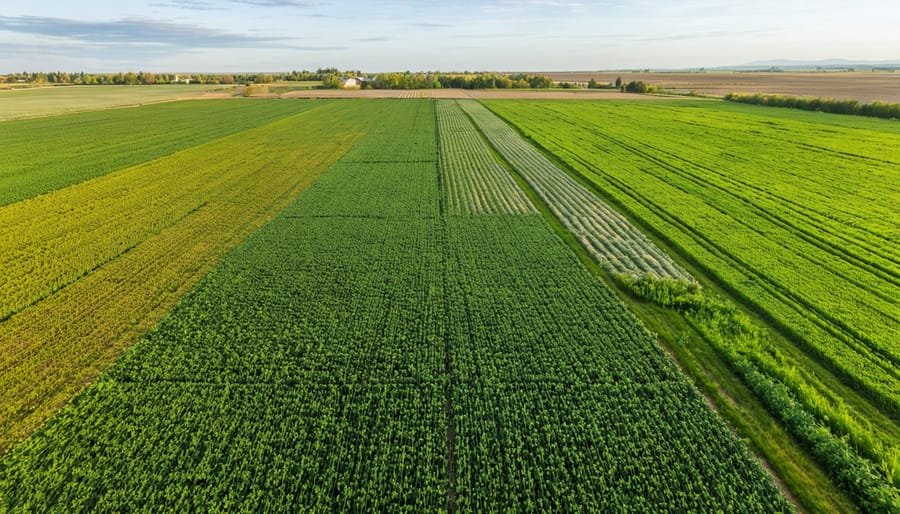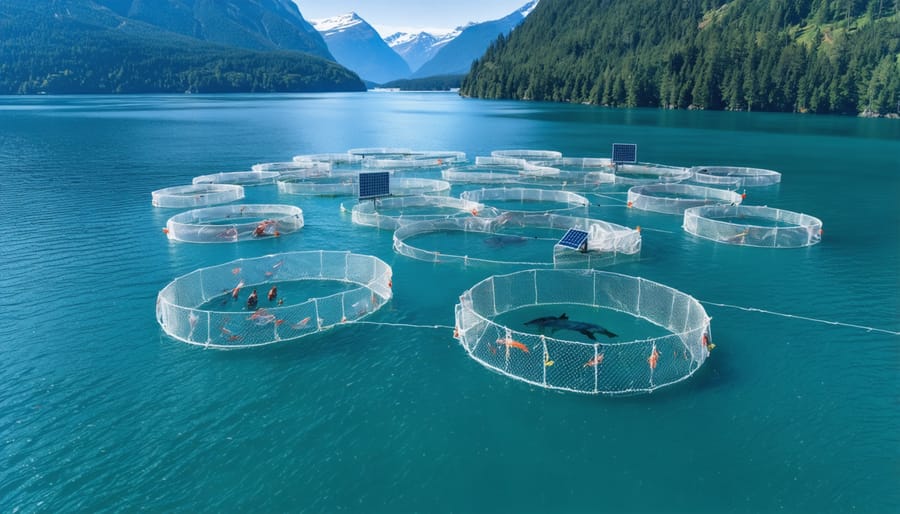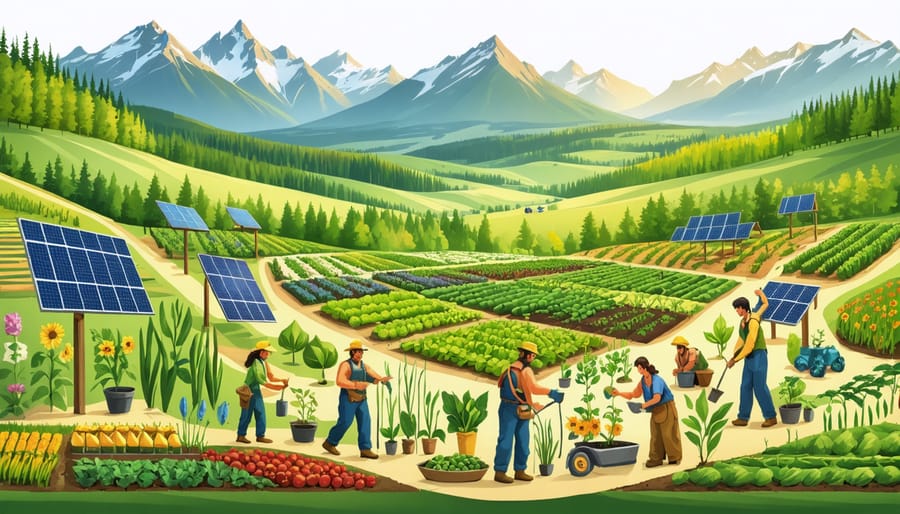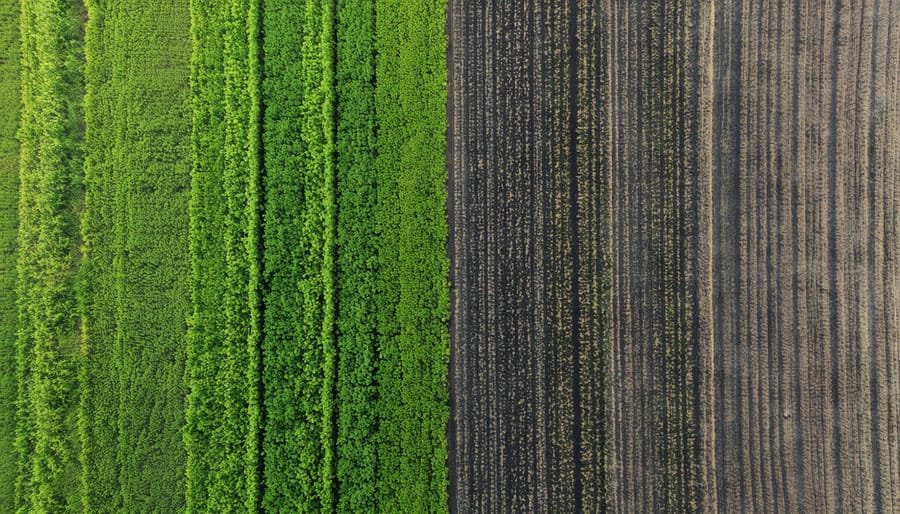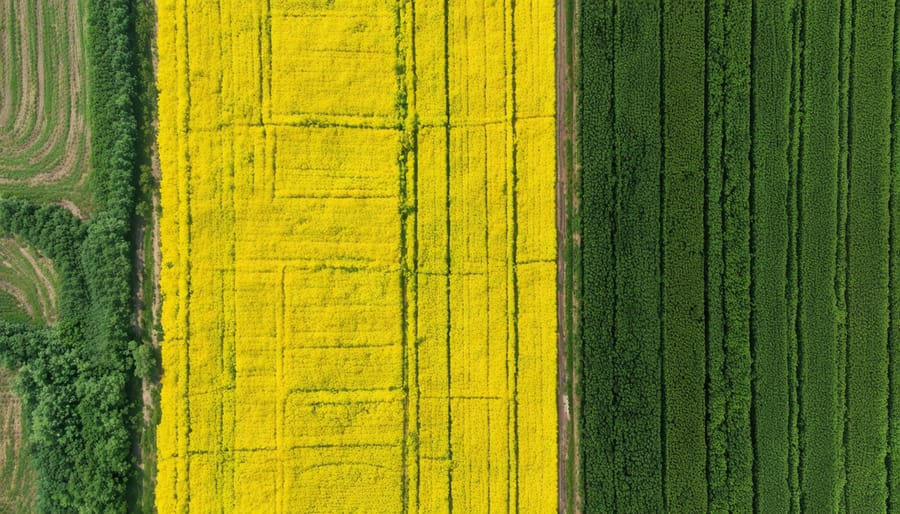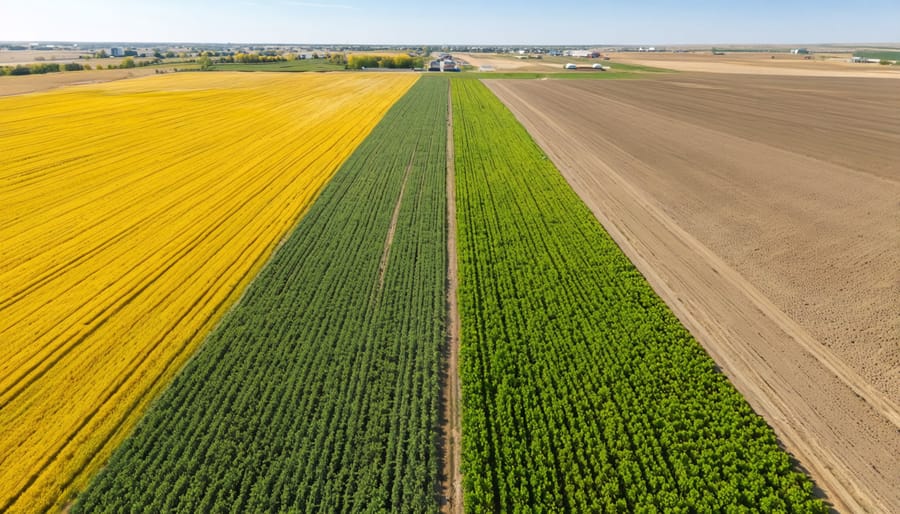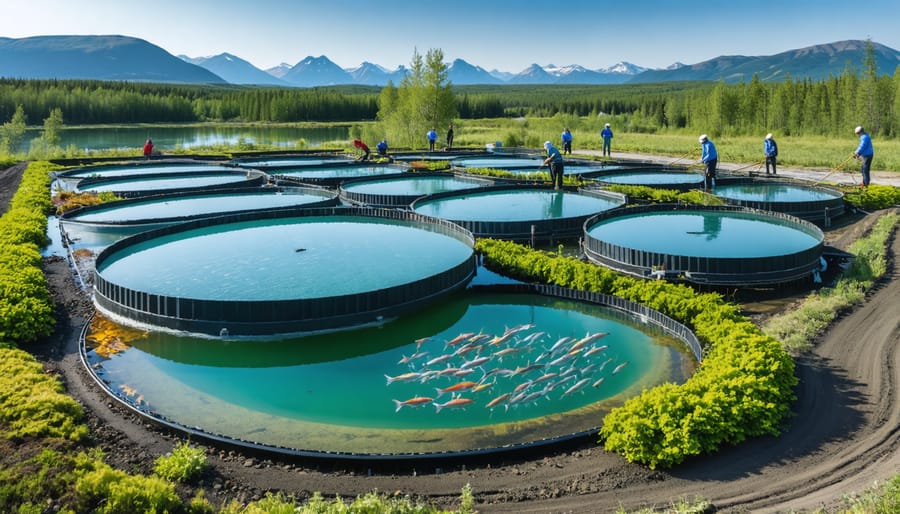As Canadian farmers face mounting pressure to boost yields while protecting our soil, regenerative agriculture emerges as a beacon of hope across Alberta’s prairies. From carbon-rich black soils in Lethbridge to the fertile Peace River region, innovative producers are proving that farming practices which rebuild soil health can match – and often exceed – conventional production volumes.
The question isn’t whether regenerative agriculture can feed the world, but rather how quickly we can scale these proven methods. Research from the University of Alberta shows that farms implementing diverse crop rotations, minimal tillage, and livestock integration are seeing up to 15% yield increases while cutting input costs by 25%. These operations are building drought resilience, reducing erosion, and sequestering significant amounts of carbon – all while maintaining profitability.
Yet regenerative agriculture isn’t a one-size-fits-all solution. Success requires regional adaptation, careful planning, and a willingness to experiment. As climate challenges intensify and global food demand rises, Canadian farmers are uniquely positioned to lead this agricultural evolution. Our vast land base, advanced technology adoption, and history of innovation in sustainable practices make us natural pioneers in proving that regenerative methods can indeed help feed a growing world – starting right here at home.
The Promise of Regenerative Agriculture in Alberta
Core Practices That Define Regenerative Farming
Regenerative agriculture in Canada builds upon several interconnected practices that work together to enhance soil health and ecosystem function. At the heart of these methods are crop diversity practices that help build resilience against climate fluctuations and market volatility.
Minimal soil disturbance stands as a fundamental principle, with many Alberta farmers adopting no-till or reduced tillage systems to preserve soil structure and organic matter. This approach is typically combined with maintaining living roots in the soil through cover cropping, which provides continuous soil protection and nutrient cycling.
Integration of livestock plays a crucial role, with planned grazing patterns that mimic natural herd movements. This practice helps distribute nutrients, reduces compaction, and stimulates plant growth. Many successful regenerative farms in Alberta rotate cattle through their cropland during off-seasons.
Maintaining soil coverage year-round through residue management and cover crops serves as another essential practice. This protects against erosion, regulates soil temperature, and supports beneficial soil organisms. Canadian farmers often use cold-hardy cover crop varieties like fall rye and winter wheat to extend the growing season.
These practices work synergistically to build soil organic matter, improve water retention, and enhance biodiversity – all while maintaining productive agricultural systems that can withstand environmental challenges.
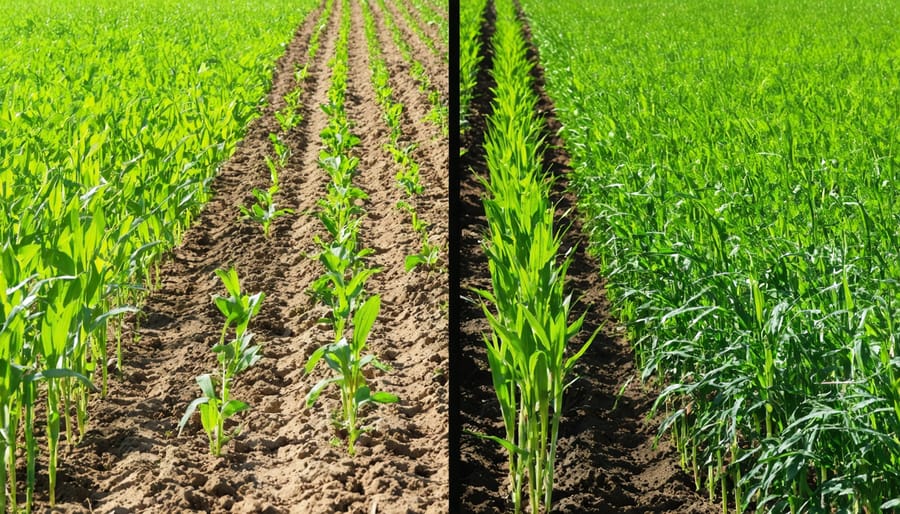
Success Stories from Alberta’s Soil
Among the many success stories from Canadian farms, Alberta’s soil champions are leading the way in regenerative agriculture. Take Doug Weatherbee, a farmer near Lethbridge, who transformed 640 hectares of conventional cropland into a thriving regenerative system. By implementing no-till practices and diverse cover crops, he’s increased soil organic matter by 2% in just five years while maintaining profitable wheat yields.
In the Peace Country region, Sarah Johnson’s family farm tells another compelling story. Their transition to regenerative grazing has resulted in a 30% reduction in feed costs while improving cattle health. Their soil water retention has notably improved, helping them weather dry spells without irrigation.
Near Red Deer, the Martinez family demonstrates how regenerative practices work at various scales. On their 160-hectare mixed operation, they’ve integrated sheep grazing with vegetable production, eliminating the need for synthetic fertilizers while increasing per-hectare revenue by 40%.
These success stories share common themes: increased soil health, reduced input costs, and improved resilience to weather extremes. Most importantly, these farmers maintain or exceed regional production averages while building healthier ecosystems. Their experiences prove that regenerative agriculture isn’t just theoretical – it’s a practical solution already working in Alberta’s diverse agricultural landscape.
Production Capacity: Myths vs. Reality
Yield Comparisons in Canadian Climate Zones
Recent studies across Canadian climate zones show promising results for regenerative agriculture yields, particularly in Alberta’s diverse growing regions. Data collected from 2018-2023 demonstrates that properly managed regenerative farms can achieve yields comparable to conventional systems, with some variations based on specific crops and local conditions.
In southern Alberta’s dry prairie region, regenerative wheat farmers reported yields averaging 92-98% of conventional systems after a three-year transition period. More impressively, these farms showed greater resilience during drought years, maintaining 85% of typical yields compared to 65% in conventional systems.
Central Alberta farmers implementing regenerative practices have seen particularly strong results with canola and pulses. A five-year study involving 12 farms showed regenerative canola yields matching conventional outputs by year four, while requiring 30% less synthetic input. Soil organic matter increased by 2.3% during this period, contributing to improved water retention and nutrient availability.
The Peace Region presents unique challenges, but farmers there report successful transitions when focusing on cover crop combinations suited to shorter growing seasons. While initial yields typically decrease by 15-20% during the first two years, farms that maintained regenerative practices for five or more years achieved yields within 5% of regional conventional averages.
What’s particularly encouraging is the yield stability across weather extremes. During the 2021 drought, regenerative farms in the Edmonton area reported only a 23% yield reduction compared to 41% on conventional farms. This resilience factor is increasingly important as climate variability affects Canadian agriculture.
It’s worth noting that yield comparisons tell only part of the story. When factoring in reduced input costs and improved soil health indicators, many regenerative farms report better profitability despite occasional yield gaps. Local success stories include the Davidson family farm near Red Deer, which maintained comparable yields while reducing input costs by 35% over six years of regenerative management.
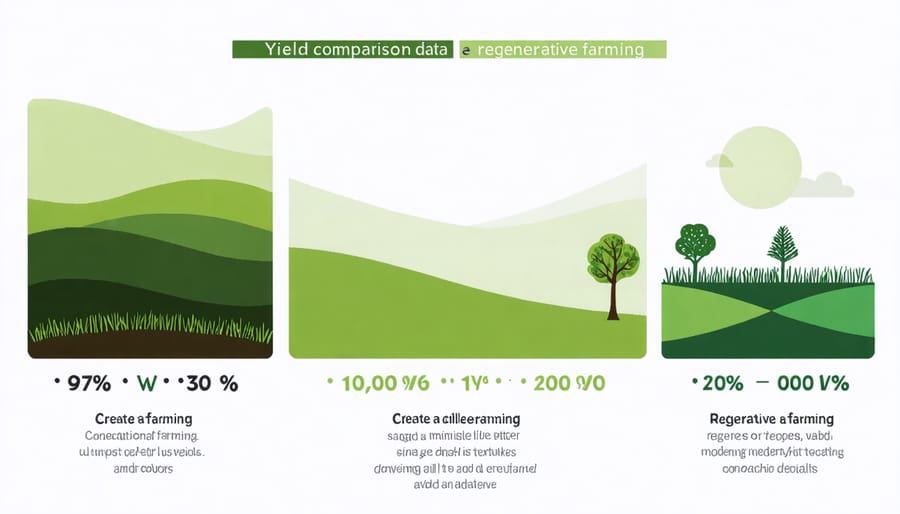
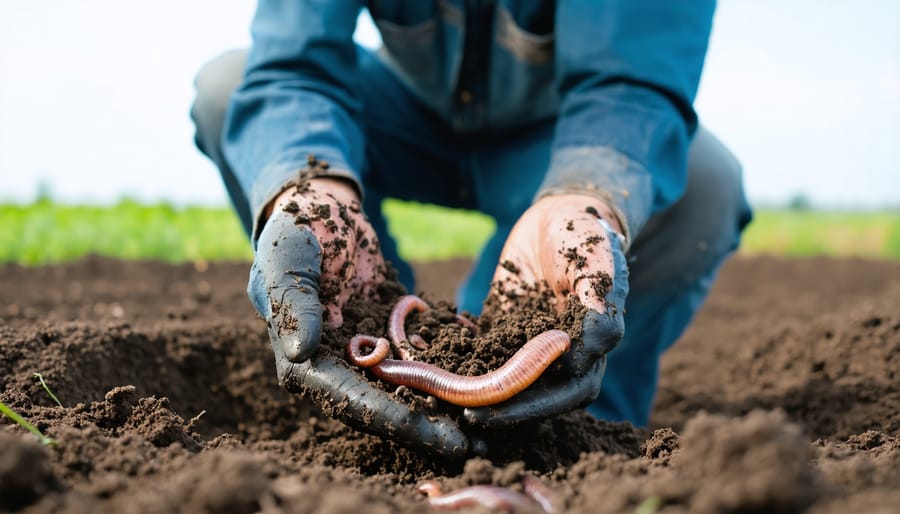
Long-term Productivity Benefits
When we invest in soil health improvements, we’re not just thinking about next season’s harvest – we’re building a foundation for generations of productive farming. Here in Alberta, farmers who have implemented regenerative practices for five years or more report significant increases in soil organic matter, leading to enhanced water retention and reduced input costs.
Take the example of Tom Henderson, a third-generation farmer near Lethbridge, who has documented a 30% increase in water holding capacity after seven years of regenerative practices. This improvement has proven crucial during dry spells, allowing his crops to maintain productivity even when neighbouring conventional fields struggled.
The long-term benefits become particularly evident in soil structure and biology. Healthy soils develop complex networks of beneficial fungi and bacteria, creating natural pathways for nutrient cycling and disease resistance. These biological processes become self-reinforcing over time, reducing the need for external inputs while maintaining or improving yields.
Research from the University of Alberta shows that farms using regenerative practices for over a decade demonstrate remarkable resilience to extreme weather events. Their soils typically contain 2-3 times more organic matter than conventional fields, translating to better drought resistance and flood mitigation.
The compounding effects of improved soil biology also support more consistent yields year after year. Many Alberta farmers report that while their initial transition period may have seen slight yield decreases, by years 3-5, their productions stabilized and often exceeded previous conventional yields, all while using fewer inputs.
These sustained improvements in soil quality create a positive feedback loop: better soil structure leads to improved root systems, which enhance nutrient uptake and water efficiency, ultimately supporting stronger, more resilient crops. This progression demonstrates how regenerative agriculture can maintain and even increase production capacity over the long term.
Scaling Up: Challenges and Solutions
Infrastructure and Market Access
For regenerative agriculture to effectively feed the world, robust infrastructure and market access systems must be in place. Across Alberta, farmers implementing regenerative practices have highlighted the need for better processing facilities, storage solutions, and distribution networks that align with sustainable farming methods. These systems are crucial for maintaining product quality and reducing post-harvest losses while ensuring products reach consumers efficiently.
Local food hubs have emerged as vital infrastructure components, connecting regenerative farmers with consumers and providing essential services like aggregation, processing, and distribution. In Red Deer and surrounding areas, farmer cooperatives have successfully established such hubs, demonstrating how innovative farming technologies can integrate with traditional marketing channels.
Transportation infrastructure presents both challenges and opportunities. While many regenerative farms focus on local markets, accessing broader markets requires reliable transportation networks. The Canadian National Railway and major highways serve as crucial arteries for moving agricultural products, but many rural areas still need improved access to these networks.
Market development is equally important. Farmers markets, community-supported agriculture programs, and direct-to-consumer sales channels have proven successful for many regenerative farmers. However, scaling up requires access to larger markets and established supply chains. Several Alberta-based initiatives are working to bridge this gap by connecting regenerative farmers with institutional buyers, restaurants, and retail chains.
Digital infrastructure also plays a critical role. Online marketplaces, inventory management systems, and traceability platforms help farmers efficiently manage their operations and connect with buyers. These tools become increasingly important as regenerative agriculture scales up to meet growing demand.
Success in scaling regenerative agriculture requires continued investment in both physical and digital infrastructure, along with policies that support market access for sustainable farming operations. The experience of Canadian farmers shows that when proper infrastructure and market access are in place, regenerative agriculture can effectively contribute to feeding local communities and broader populations.
Knowledge Transfer and Training
The transition to regenerative agriculture requires a robust support system of knowledge sharing and practical training. Across Alberta, farmer-to-farmer mentorship programs have emerged as one of the most effective methods for sharing real-world experience and location-specific insights. These programs pair experienced regenerative farmers with those beginning their transition, creating valuable learning opportunities and lasting community connections.
Educational institutions like Olds College and Lakeland College are now incorporating regenerative agriculture principles into their agricultural programs, preparing the next generation of farmers with both traditional and innovative farming methods. These programs combine classroom learning with hands-on experience at demonstration farms, where students can witness the long-term benefits of soil-building practices.
Professional development workshops and field days organized by agricultural organizations provide practical training in specific techniques such as cover cropping, rotational grazing, and soil health monitoring. The Alberta Soil Health Coalition, for example, regularly hosts events where farmers can learn about soil testing methods and interpreting results to make informed management decisions.
Digital resources have also become increasingly important for knowledge transfer. Online platforms offer webinars, virtual farm tours, and discussion forums where farmers can connect with experts and peers across the country. These resources are particularly valuable for remote communities and during off-season months when in-person training might be limited.
Technical support from agricultural extension services plays a crucial role in helping farmers navigate the transition period. These services provide soil testing, biological monitoring, and customized advice for different farm operations. Many regenerative farmers in Alberta emphasize the importance of having access to knowledgeable advisors who understand both conventional and regenerative methods.
Success in regenerative agriculture often depends on adapting practices to local conditions. Regional learning hubs have been established throughout the province, where farmers can access location-specific information and connect with others facing similar challenges in their climate and soil type. These hubs serve as important centers for ongoing education and community building in the regenerative agriculture movement.
Economic Viability for Canadian Farmers
Cost-Benefit Analysis
The transition to regenerative agriculture requires careful financial planning, but research shows it can significantly improve farm profitability over time. Initial costs typically range from $200 to $600 per hectare, covering soil testing, equipment modifications, and cover crop seeds. However, Alberta farmers who’ve made the switch report breaking even within 2-3 years through reduced input costs.
Studies from the University of Alberta demonstrate that regenerative practices can cut fertilizer expenses by 30-50% and decrease irrigation needs by up to 40% after the first three years. Labour costs may initially increase during the transition but often stabilize as soil health improves.
Long-term financial benefits include enhanced drought resilience, reduced pesticide requirements, and premium pricing opportunities. Prairie farmers implementing these methods report net profit increases of 15-25% after five years, primarily through lower operational costs and improved yield stability.
Carbon credit programs in Alberta now offer additional revenue streams, with payments ranging from $15 to $30 per tonne of sequestered carbon. Equipment sharing cooperatives and government transition grants can help offset initial investments, making the shift more accessible for small and medium-sized operations.
The key is phased implementation, allowing farmers to test methods on smaller parcels before scaling up, thereby managing risk while building experience and confidence in the system.
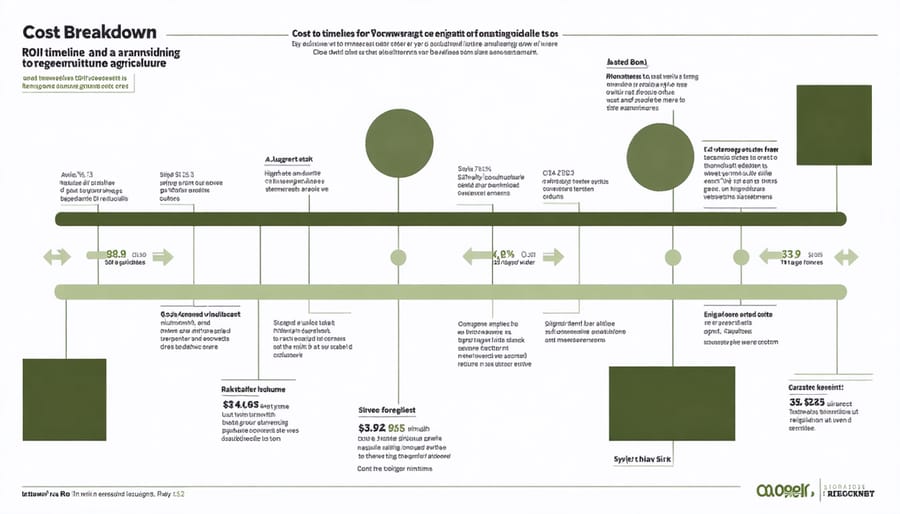
Available Support Programs
Canadian farmers looking to transition to regenerative agriculture practices have access to several supportive programs and funding opportunities. The Canadian Agricultural Partnership (CAP) offers cost-sharing initiatives for soil health improvements, including cover cropping and rotational grazing systems. In Alberta, the Environmental Stewardship and Climate Change Producer Program provides grants of up to $70,000 for implementing sustainable farming practices.
ALUS Canada (Alternative Land Use Services) works directly with farmers and ranchers, offering annual payments for land dedicated to ecological projects that enhance soil health and biodiversity. The Prairie Soil Carbon Balance Project supports farmers with technical assistance and financial incentives for practices that increase soil carbon sequestration.
Local agricultural societies and producer groups often provide mentorship programs, connecting experienced regenerative farmers with those beginning their transition. The Organic Science Cluster, funded by Agriculture and Agri-Food Canada, offers research support and knowledge transfer for regenerative practices.
Financial institutions like Farm Credit Canada have developed specific lending programs for sustainable agriculture initiatives, offering flexible terms and competitive rates. Additionally, several conservation authorities provide technical support and funding for water management and soil conservation projects.
These programs demonstrate growing institutional support for regenerative agriculture, making the transition more accessible and financially viable for Canadian producers.
As we’ve explored throughout this article, regenerative agriculture holds significant promise for addressing global food security while maintaining the economic viability that Canadian farmers need. The evidence from Alberta farms shows that when properly implemented, these practices can match or exceed conventional yields while improving soil health and reducing input costs over time.
The success stories we’ve seen across the Prairie provinces demonstrate that regenerative methods can work at scale, particularly when farmers adopt a gradual, systematic approach to implementation. While the transition period requires careful planning and potential adjustments to operations, the long-term benefits – including enhanced drought resilience, reduced fertilizer dependency, and improved profit margins – make a compelling case for this agricultural model.
However, it’s important to recognize that regenerative agriculture isn’t a one-size-fits-all solution. Each farm requires a tailored approach based on its unique conditions, resources, and goals. The key lies in combining traditional farming wisdom with modern regenerative practices, supported by ongoing research and community knowledge-sharing.
Looking ahead, the potential for regenerative agriculture to contribute to global food security appears promising, especially when considered alongside other sustainable farming innovations. As more Canadian farmers successfully integrate these practices, we’re seeing that feeding the world sustainably isn’t just an idealistic goal – it’s becoming an achievable reality.
For Alberta’s agricultural community, the path forward involves continued learning, adaptation, and collaboration. By sharing successes, challenges, and lessons learned, we can work together to build a more resilient and productive food system that benefits both farmers and the planet.



